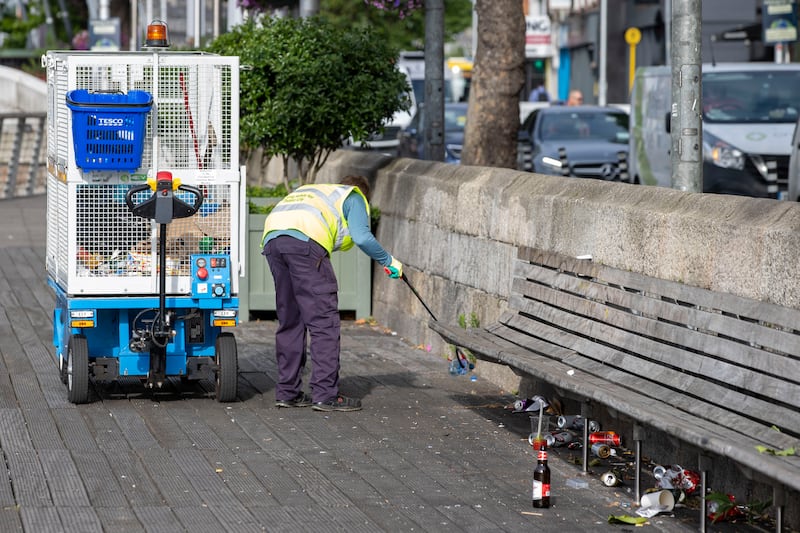A wind carrying the chill of autumn is blowing up Dublin’s river Liffey, though it doesn’t deter those who have flocked to the Liffey Boardwalk. The benches along the quay wall are full in several places on this walkway suspended over the river’s edge. It stretches the 900m distance from Grattan Bridge at Capel Street to Liberty Hall.
Now approaching its 23rd birthday – the first section opened in December 2000 – the oft-maligned boardwalk is a hive of activity. Those sitting on the benches, or taking a walk, on this late Wednesday afternoon are an eclectic mix: relaxed tourists, office workers on a break, groups of young people – mostly women – catching up, and those who appear to have fallen on hard times who look like they have nowhere else to go.
The unmistakable odour of cannabis fills the air in several places and a handful of people are drinking from beer cans or naggins of vodka. But the atmosphere is very relaxed and not in the least bit threatening, despite the “no go area” narrative that has sometimes followed the boardwalk.
One thing is clear; even on a cool midweek afternoon, after the summer months and lunchtimes have run their course, this is a very popular amenity. Michael McGarry says Dubliners have embraced the boardwalk over the past two decades to the extent that it’s now part of the city’s identity.
McGarry and Siobhán Ní Éanaigh, of McGarry Ní Éanaigh Architects, were the lead designers of the boardwalk, working with Muir Associates Consulting Engineers. It was a “millennium project” that sprang from the minds of what McGarry calls a Dublin City Council “triumvirate”: then city manager John Fitzgerald, city architect Jim Barrett and city planner Dick Gleeson.
“The three of them had a very ambitious take on what Dublin should be,” he says.
“It was vaguely based on Barcelona, in terms of what the city might mean for its citizens. Before that triumvirate arrived, I’m going to say the city council’s only idea about the city was emptying bins and turning on traffic lights. There was no sense the public realm had a value.”
McGarry says the Liffey “stank” for many years and even in the 1990s it was little more than a “trench” that divided Dublin into north and south. However, as Temple Bar became more successful, Barrett wanted to draw people from there towards the Liffey. In a bid to make more of an amenity of the river, the boardwalk idea emerged.
The project was planned out and funding was secured from central government before the council went public with the idea. McGarry says there was no public consultation process, like that which would happen now, and the project was simply devised, designed and then “launched straight into planning”.
“The boardwalk meant people would be aware of the river and the amenity that the river is; to sit and walk on something that was over water but south facing, so if the sun is out at all, it’s really pleasant,” he says.
After the first stretch was opened – from O’Connell Bridge to Grattan Bridge – McGarry says a coffee kiosk was “battered” by vandals armed with sledgehammers on the first weekend.
[ Dublin’s Liffey boardwalk: ‘It could explode in a second’Opens in new window ]
“But that settled within a matter of weeks,” he adds. “And then it became popular and I still think it’s popular. But now there’s a discussion about the amount of drug dealing or not.”
To the suggestion that the boardwalk is a hostile, even dangerous, place, McGarry is unconvinced. He says it hosts all the life in the city, some of which is unsavoury, and insists he is “dead proud” of his involvement in the project.
“I see it on postcards. You see it on social media and it’s part of the image of the city, absolutely,” he says.
He points out the remodelling of Smithfield, with which he was also centrally involved, and the rejuvenation of Henry Street and O’Connell Street, which all occurred around the same time. Those projects, and the boardwalk, were the “last radical urban design interventions” to improve the north inner city, he says.
One of McGarry’s colleagues at the time, Matt MacDonagh-Dumler, was newly arrived from the US, where he grew up in an Irish family, and jumped into working on the design of the boardwalk and steel frame that holds it in place. He said the team working on the project wanted to design a light structure that would respect the quay walls and not take from their character.
“Originally it was planned for the south quays,” he says. “But as it would have been in the shadow – which would have created a very slippy surface due to the lack of sunlight – the north side was preferred.”
He points out as the north quays are south facing, the quay walls heat up, and then release that heat, in the area where people sit on the boardwalk benches. The structure was also designed to sit close to the water in order that the quay wall would provide significant shelter from passing traffic along the north quays. A 4m-wide boardwalk was chosen because anything narrower would not allow groups to stand to the side and still offer enough space for others to walk past. A wider structure would likely have no atmosphere.
MacDonagh and Ní Éanaigh chose ekki, a very dense hardwood, because it was so durable. He points out most of the walkway structure today is still the original wood put in place almost a quarter of a century ago.
“I remember coming down here shortly after the benches were installed and seeing people down here eating their lunch on the boardwalk and it was a great feeling,” he says during a stroll along the walkway.
Of late, the boardwalk is something of a tale of two cities. When The Irish Times visited, four sections had been power washed and were notably clean. As a result, they were more welcoming and, unsurprisingly, much busier. Indeed, the deep cleaning – of the walkway, the wooden handrail and the quay walls – has had a transformative impact. But the two sections that run from O’Connell Bridge to Liberty Hall were badly in need of maintenance and that made for a much more unpleasant, even slightly menacing, environment.
Walking the full length of the boardwalk – from the neglected sections on to the clean areas – offered real insight in how much better parts of the north city would look, and how much safer they would feel, if Dublin City Council redoubled its efforts to keep the streets clean, especially with power washing.
And what of the reputation for drinking, drug-taking, muggings and violent incidents that has dogged the boardwalk; is it more dangerous than other parts of the north inner city?
Gardaí said, from a policing perspective, nothing unique occurred on the boardwalk.
“It’s no more challenging or dangerous than, say, the lanes off Temple Bar just beside it,” said one garda. “It’s definitely not a no-go area and you’ll see that when you go down there.”

Another agreed, adding while drug dealing took place on the boardwalk “that’s a Dublin problem, not a boardwalk problem”. It seemed to him there was a perception, justified or not, that the boardwalk was more unsafe than other parts of the city.
The garda believed many of those who congregated on the boardwalk were homeless people being accommodated in hostels in north central Dublin, who were not permitted to stay in their accommodation during the day. He insisted very few caused trouble.
“If you have that concentration of hostels in the area and they’re all put on the streets every day, people have to go somewhere,” says the garda.
McGarry says he has heard people say the benches should be taken from public places in Dublin to prevent people gathering for antisocial behaviour. But he is adamant attractive public places must be created to give Dublin a sense of itself, in the way many continental European cities have such a strong identity.
The idea that we wouldn’t put benches into public places – it’s the pits. Talk like that just lowers our expectations,” he says. “There might be other ways to deal with the city drug problem rather than flapping about the benches on the boardwalk.
“What kind of culture have we that we’re going to reduce everything to simple banality: ‘If we have a bench we have drug dealing so therefore we won’t have benches and the drug dealing will go away’... nonsense.”


















